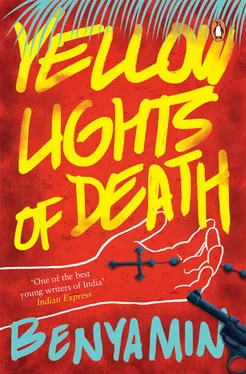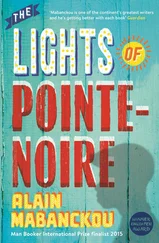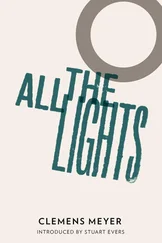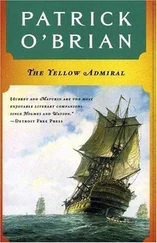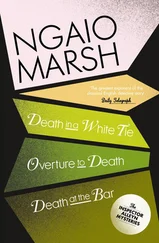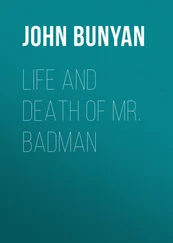‘If you’re interested, there is no harm in seeing it. But you ought to be reverential.’ He pulled open a rack for me. ‘In the memory of our forefathers, we keep three things in these racks. One, the portrait of the forefather, drawn by the best artist available in Diego at the time. Two, his most favourite object. Some choose the object when they’re alive. When I die, you should keep the crown in this room. That meaningless crown symbolizes my life.’
What would Jeff choose to be kept in this room? It would be his favourite laptop, what else? What would I choose if I get a chance? The novel which is to be written!
‘The third item is the most important thing,’ Valyapapan said. ‘It’s called the hasta phalakam .’
‘Hasta phalakam? What’s that?’ I was eager to know.
From the rack, Valyapapan pulled out a small wooden casket. Its lid was sealed with wax.
‘This is the hasta phalakam box. It is believed that this was the idea of Hormis Avira Andrapper, who was extremely intelligent, a visionary. He must have envisioned every generation that would follow him. That each one of them should leave a distinct mark on this earth. That’s why he introduced this hasta phalakam box as a mandatory custom in the Andrapper family. Only someone who could see ahead in time could have come up with such an idea. Those who think only of the contemporary world can’t grasp his logic.’
Valyapapan softly scraped away the wax seal. Then he opened the lid and held the box up to the light. Inside was a clay plate with someone’s hand impression. There was blue paint on it. The colour highlighted the lines, crests and troughs clearly.
‘This is the right-hand impression of our forefather John Andrapper,’ Valyapapan said, pointing at the name on the label of the rack we had opened. ‘Look at this. This is the hand that guided this family for a long time.’
I took the box from him with both hands. Then, as if it was a baby, I kept it close to my chest and looked at it for a long while. A hand impression made centuries ago. The lines of time lay deep in it. A smart person could not only read these lines to decode his life, but also the times. Who could arrange a better memory for tomorrow!
‘Tell me everything about the hasta phalakam,’ I said.
‘It is brought in on the day the head of the family dies. The box is filled with the best soil available in Diego, mixed with clean sand and glue in a particular proportion. The hand of the dead father is then imprinted on it. He leaves the world after gifting this to time. Once the clay dries up, it gets coated with blue paint, to make the impressions sharper.’
I looked at it for some more time before returning the box. Valyapapan closed the lid, resealed it with wax and put it back on the rack. Then he pulled out another box. It contained a pure-white porcelain bowl with drawings in gold on the rim. Probably a Chinese bowl. That must have been the favourite object of John Andrapper.
Valyapapan then showed me a framed picture. In typical Portuguese attire of the era, my ancestor John Andrapper solemnly looked at me.
‘The Room of Forefathers is not a museum. It’s the life of our family,’ Valyapapan said, closing the almirah. ‘Don’t go around telling people about this. We should maintain the privacy of the family.’
In front of the almirah that contained generations within it, I stood a long time, with folded hands.
Kanyabhogasooktham
VALYAPAPAN WENT BACK to his recliner. Among the books and documents in the room, I began to search for references to Diego. It was a more massive and significant collection than I had imagined. Some I opened and read, for fun.
The first one I stumbled upon was a deal struck by the French government and Diego on the official language:
Le français restera langue officielle des Dego Garcia aussi longtemps que les représentants élus de la population n’auront pas pris une décision différente.
(The French language shall remain the official language of Diego Garcia as long as the elected representatives of the people shall not decide otherwise.)
Article XXVXI of Traite de Cession
It was in violation of this deal that the British authorities, in 1975, through a decree, declared English as the official tongue. How many similar violations have there been! The history of them is called Diego!
Another file I saw had a crucial order of authority that the French East India Company handed over to the Andrapper family. Its loose English translation is:
The Andrapper Family, of Portuguese lineage from Andrew Pereira, now headed by Hormis Avira Andrapper, will be the de facto owners of Diego Garcia and the rest of the Chagos Archipelago such as Peros Banhos, the Salomon Islands, the Three Brothers (Islands), the Egmont Islands and the Great Chagos Bank.
Diego Garcia and the Chagos Archipelago will be ruled and administered by the Andrapper family, but the land will remain and serve as a coiling station for French ships at the Indian Ocean. The French East India Company does not have any plan to develop the land as a French Colony.
The family will have all the de facto authority to rule the Inhabitants, Migrants, Workers and Slaves. All the income from the land, plantations, industries and the atoll will go to the family, and no tax will be paid to the French East India Company.
This is a mutual agreement made between the Andrapper Family and the French East India Company.
Article XXVII of Traite de Cession
There were also a lot of rare books. Thomas Stephen’s History of Christ , Abraham Rogers’s translation of Bharthrihari, Fr. Roths’s Sanskrit grammar, and Fr. Zha Kalmethy’s translation of the four Vedas were among them. In the same shelf were Benjamin Bailey’s short essay Madyanirodhini , Raja Ram Mohan Roy’s interpretation of the Upanishads, and King Bhoga’s Samarangana Sutradhara . Then there was a translation of the book The story of Phulmani and Karuna , written by Catherine Hana Mullens, alongside Interesting Tales by an Outsider for India’s Women .
Who among my ancestors had been such a lover of books? A man interested in collecting books? It could not have been Valyappachan Rostin Andrapper. There was no proof of his interest in literature. It must have been someone before him. Felix Andrapper? Samuel Andrapper? Stanley Andrapper? Whoever it was, it must be from him that I got my love for books. The stories he had wanted to write might finally be written by me. These desires never die. They get transferred, through one’s genes, down through generations, till they manifest at some point.
I also found valuable documents of Diego Garcia’s history from the Room of Forefathers. A logbook titled A French Ship’s Journey to India—1642 was the most remarkable of them.
To the east of Venecia’s St. Raphael Airport lies a small village called Sanchi. Most of its inhabitants are Buddhist refugees from Sri Lanka. A bodhi tree with large, spreading branches is the landmark of Sanchi. Believers claim the tree is over two thousand years old. According to the Buddhists in Diego, Mahendra and Sanghamitra, who left the subcontinent to spread the religion in Sri Lanka, lost their way and first landed in Diego. They were said to have planted a branch of the bodhi tree here, and another one in Sri Lanka. As they were from a place called Sanchi, this region also came to be called under the same name, according to legend.
The Buddhists of Diego rely on this logbook as evidence to prove that they were the first inhabitants of the island. It was because of this book that they enjoyed special status and Senate positions.
I flipped through the pages with interest. It was a travelogue by Vice Admiral Theogin, captain of the French war vessel La Favorite that had been to many countries. The voyage began at Le Havre in France and continued to various ports such as Rabath, Banchu, Seytna and Tholanaro, before the ship went to Goa. It finally anchored at Diego’s eastern side in May 1642. Theogin refers to Sanchi as Seynchi.
Читать дальше
